Two lovely evergreen ferns of Japan are Coniogramme intermedia and C. japonica. Of the two, C. japonica has become well known in western horticulture as the “bamboo fern”, but the other is rarely, if ever seen. Both are remarkable ferns, worthy of a place in any collection, and harbor a hope of being fairly cold hardy.
Coniogramme intermedia is a medium to large size evergreen fern with a short creeping rhizome. The fronds are basically once pinnate, deep green, glossy, and up to 60-100 cm long and 25-35 cm wide. The basal pinnae can be divided once more, sporting shorter pinnules, but these number few and the apical pinnule is the largest by far. The pinnae have lightly toothed margins. The scaleless stipe accounts for approximately 1/3 or the frond length. The naked sori occur in lines that follow the pinnae veins. These can separate up to three times but never cross one another, and extend up the veins 1/2 to 3/4 of the way to the margin of the pinnae only.
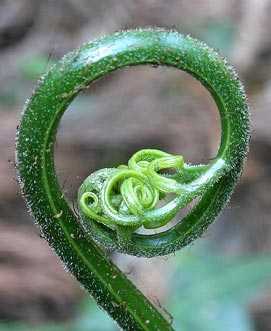
This fern is commonly seen as single clumps in wet forests, often along streams and seeps from low to mid elevations, 100-600 meters, on Kyushu Island. It is a widespread species, growing across Japan from Hokkaido and southward. It is also reported from Korea, Taiwan, and China.
Of the two Coniogramme species found in Fukuoka, this one is the more lovely to my eye. It tends to grow its pinnae more close together, and they are broader in comparison with those of C. japonica, giving it a more robust and luxuriant look. An added feature is that the pinnae taper rapidly towards their ends, thus producing a tail-like shape. The pattern of the sori also differs from its cousin. The naked sori occur in lines corresponding to the leaf veins, and these can branch two and sometimes three times, but these divisions never cross over each other. Also, the sori never extend fully out to the margins of the pinnae, but usually fall well short. In C. japonica the sori often cross over to each other and they extend nearly to the margins of the pinnae.
This is a common fern in moist valleys and near streams and can often be seen growing with its cousin C. japonica. Several varieties have been recognized and named, their differences mostly having to do with pinnae shape and how far the sori extend to the pinnae margin. A natural hybrid, C. x fauriei, also exists between this species and the more common C. japonica.
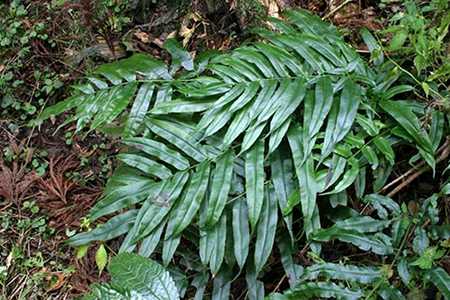
C. japonica is larger growing than its relative, but likewise is evergreen. The fronds are twice pinnate and glossy, growing up to 60-100+ cm long and 40-60 cm wide. The pinnae are divided half way up the blade, and the remaining pinnae are undivided. The basal pinnae are the most divided, having four to six pinnules each, giving the frond a more complex look. The pinnae have lightly toothed margins and taper gradually to form a lanceolate shape. The scaleless stipe accounts for approximately 1/3 or the frond length. The naked sori occur in lines that can branch up to three times and occasionally cross over one another, and extend up the veins almost to the pinnae margins.
It is commonly seen as single clumps in wet forests, but sometimes forms loose and occasionally dense colonies, often intermingled with C. intermedia and other ferns. Wet to moist woods along streams and seeps from low to mid elevations, 100-600 meters, are to its liking. It is found across Japan from northern Hokkaido and southward; also Korea, Taiwan, and China.
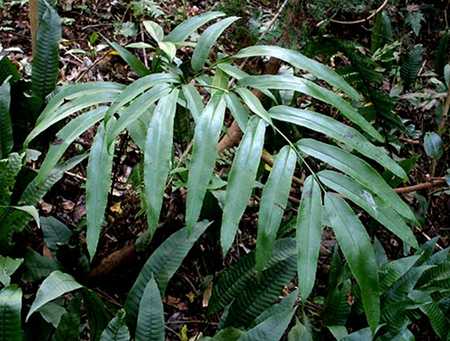
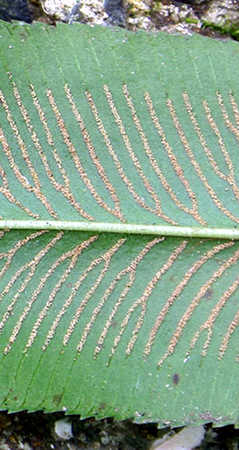
This fern is easily mistaken for C. intermedia since they have a similar outward appearance and occur in the same habitats, often in mixed colonies. The differences lie in the shape of the fronds and the pattern of the sori. While C. intermedia has the appearance of being only once pinnate, this species clearly is not. The pairs of opposite pinnae are divided once again at least half way up the frond. The basal pinnae are the most divided and can sport up to four or more pinnules each. Furthermore the space between the pinnae and pinnules is wide, giving the frond an almost palm-like look. The pinnae and pinnules themselves also differ in shape to those of C. intermedia. They taper slowly to their ends thus producing a pointed, lanceolate form, very unlike the fast tapering ones in C. intermedia. Also, while both species have naked sori (they have no indusia), the pattern of these are distinctly different. Young sporlings of these two species are often hard to tell apart, but as they age the differences become apparent.
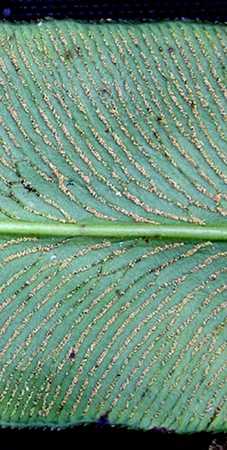
These ferns need a moist soil and prefer bright shade. Any reasonable organic rich compost will do, as would a good acidic woods loam. I have no direct knowledge of their cold hardiness, but since they both occur as far north as Hokkaido, I would guess that those populations are indeed cold resistant. I would venture a guess of USDA zone 7 and perhaps colder for them, with C. japonica being perhaps a bit more cold tolerant since it is found all the way to northern Hokkaido where winters can be severe. In warmer areas they remain evergreen in winter, but I would imagine them to be deciduous on the northern end of their range. Sometimes C. japonica is available in the USA and Europe under the name “bamboo fern”, while C. intermedia seems to be largely unknown. There exists a lovely variegated form of C. japonica, f. flavo-maculata, that is sometimes offered in the trade. I’ve grown both the normal and variegated types and they seem to respond to the same treatment equally.
To see these species in their native woodlands in southern Japan, please check out this video:
Here are two lovely subtropical looking ferns to add to one’s garden. The hardest part will be locating them, in particular C. intermedia. If you can get a hold of them, I recommend them highly for the woodland garden.
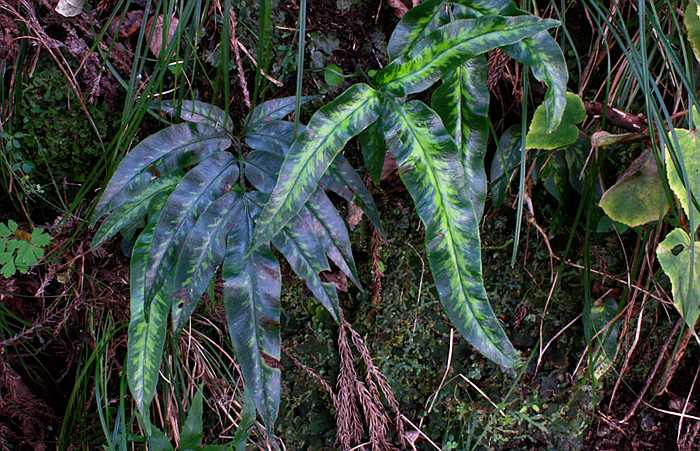

Have you ever led groups to Japan to explore areas with ferns in natural settings? I lead garden turs to Japan and someone just asked me to put together a tour such as this. I am wondering if you would be interested in collaborating on this tour. I am in the Seattle WA area, a docent at the Japanese Garden in Seattle’s Arboretum, and work maintaining upper end gardens.
Hi Marilyn,
No, I have not done a tour, although more than one of my non-botanical friends has had to endure my ramblings on hikes before… poor devils! I’ll send you a private message about this soon. Thanks for asking.
Hi Tommy, I just found your reply today 3/12 and yesterday I emailed you again on this subject.
I am so happy to hear from you as I had a meeting today with the Fern Society representative and they definitely want me to put a tour together for 2014. I showed her your youtubes on ferns and she thought they were wonderful. So we definitely plan to come to Kyushu and want to hire you
To go on a hike with us. Participants will be from the Seattle area, England and maybe Germany.
My husband has been researching the Japanese web sights and found a 45 minute hike in Gifu
Prefecture that supposedly has over 100 species of ferns. I am not sure that I can believe this.
It is best to email me directly.
Marilyn
Hey Marilyn, so sorry, been busy like no one’s business the last two weeks. I WILL email you soon.